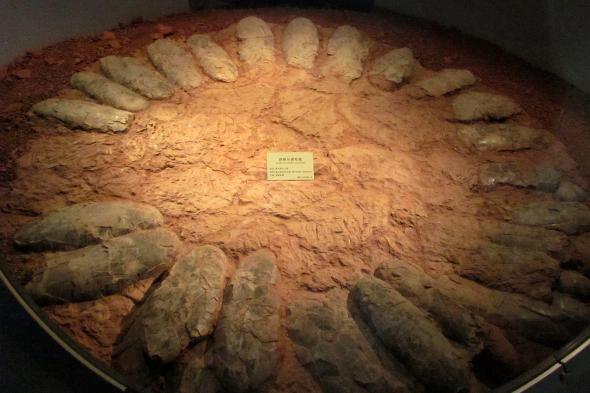How Giant Dinosaurs Sat on Their Eggs Without Crushing Them?

Imagine a hummingbird sitting on a tiny nest filled with even teenier eggs. Adorable, right? Now picture a dinosaur the size of a fully grown hippopotamus settling onto its eggs—sounds like a recipe for a dinosaur omelet.
But a new study of dinosaur nests, along with a stunning, newly revealed fossil of a dinosaur that died tending its eggs, shows that heftier dinosaurs did have a strategy to avoid squashing their young: carefully stacking their eggs in a ring around themselves in the nest.
The findings, published today in the journal Biology Letters, provide a rare glimpse into how nesting behaviors seen in today’s birds got a start among their dinosaur ancestors.
“Most likely this behavior of sitting on the nest evolved first in dinosaurs,” says study coauthor and paleontologist Darla Zelenitsky of the University of Calgary in Canada.
CRUSH-PROOFING 101
Zelenitsky’s team studied 40 nests built by oviraptorosaurs, birdlike dinosaurs that lived more than 65 million years ago. These animals ranged in weight from a few pounds to about 4,000 pounds, with the largest among them similar in bulk to a modern hippopotamus or rhinoceros. Their nests in turn could be anywhere from about a foot wide to a colossal 10 feet.
In smaller nests, Zelenitsky says, eggs were clustered with little or no open space in the center. As the dinosaurs and their nests got bigger, the creatures left more and more space in the middle to sit, creating elaborate piles of eggs.
“The photos don’t do these clutches of eggs justice,” she says. “They’re two to three layers of eggs, and they’re stacked in a spiral that inclines up toward the center of the nest.”
As for why the dinosaurs built nests in the first place, Zelenitsky says it’s hard to know for sure. “Most birds sit on eggs to provide heat to the eggs,” she says. “But we don’t know if that was the case with oviraptorosaurs—we don’t know if to provide shelter or protection, or for warmth.”

A RARE FIND
In April, another team unveiled a spectacularly preserved example of a dinosaur in a nest, found in Mongolia’s Gobi desert and described by the American Museum of Natural History.
“This is the rarest of the rare,” says paleobiologist Greg Erickson of Florida State University in Tallahassee, who collaborated with study leader Mark Norell of the AMNH. The National Geographic Society partly funded the 1995 expedition that discovered the specimen.
The dinosaur, known as Citipati osmolskae, was a roughly emu-sized oviraptorosaur. It was most likely either buried alive by a collapsing sand dune, or it died in a sandstorm and was then covered by sand, Erickson says, preserving its position on the nest. Consistent with the other new findings, the eggs were arranged in a ring with a central opening that could have carried at least some of the adult’s weight.
It’s not clear whether the dinosaur was male or female, and Erickson points out that males tend the nests of some modern birds. Either way, “it was a very good parent,” he says. The animal died with its winglike arms still stretched over 12 eggs. Today’s birds use the same pose to camouflage their eggs or protect them from the elements.
EARLY BIRDS
“All of this is more evidence of the fact that birds evolved from dinosaurs,” says paleontologist and National Geographic grantee Stephen Brusatte of the University of Edinburgh in Scotland.
“A lot of us were brought up on this idea that dinosaurs were big overgrown lizards, lumbering and dimwitted, and that’s just not the case at all.” Instead, he says, many dinosaurs were very birdlike.
In fact, adds Erickson, “you can walk outside today and see 10,000 species of dinosaurs fluttering about.”
